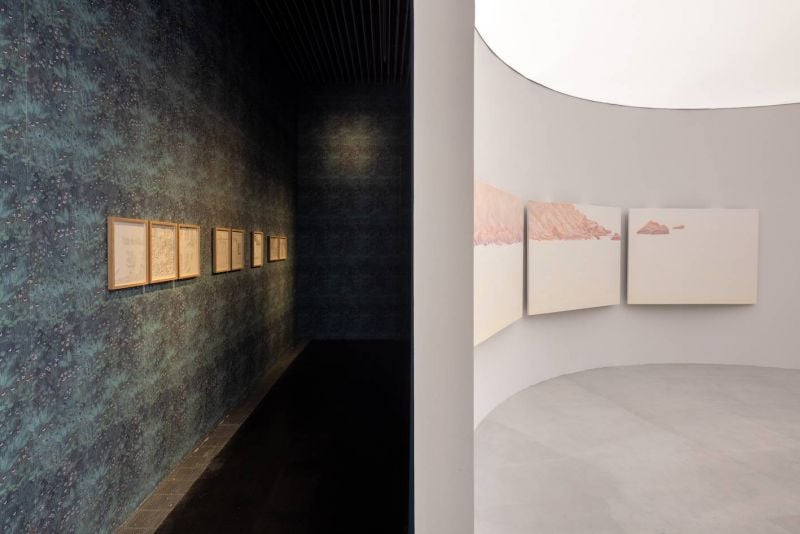
Daniele Genadry. Apparitions installation view, 2022. (Credit: Daniella Baptista, courtesy of the artist and Jameel Arts Center)
BEIRUT — You might imagine Daniele Genadry paints landscapes. Terrestrial features do feature in her work but the Lebanese artist is particularly concerned with how humans perceive and apprehend landscape. She is interested in the various facets of light and how, playing upon distant mountains, say, or moving water, it can give you pause.
“I feel that there is a specific mode of perception that is appropriate to Lebanon,” she says from her Paris studio. “It is tied to an awareness of instability, of things potentially disappearing. As a result there is a heightened or intense vision that I find generative.”
Genadry spoke to L’Orient Today a few days after returning from Dubai. Jameel Arts Centre is hosting an exhibition of her paintings and sketches titled “Apparitions,” her latest collaboration with architect and philosopher Fares Chalabi.
A decade of rendering light
Genadry’s interest in ways of looking derives from her time in Lebanon, but she’s been a citizen of the world for much of her life. She’s currently in the midst of a residency in France, and lived in the US and Italy before taking a teaching position at the American University of Beirut. The contingent mode of perception she experienced in Lebanon has been internalized, shaping the three oil-and-acrylic canvases that are the principal works in “Apparitions.”
All three works depict the vistas characteristic of the artist’s major works. In “The Fall” (2015), the foreground of a mountain scene emerges in predominantly orange hues from the left side of the frame, while its foothills and the range that retreats from the escarpment into a background — the center of the piece — seem shrouded in haze.
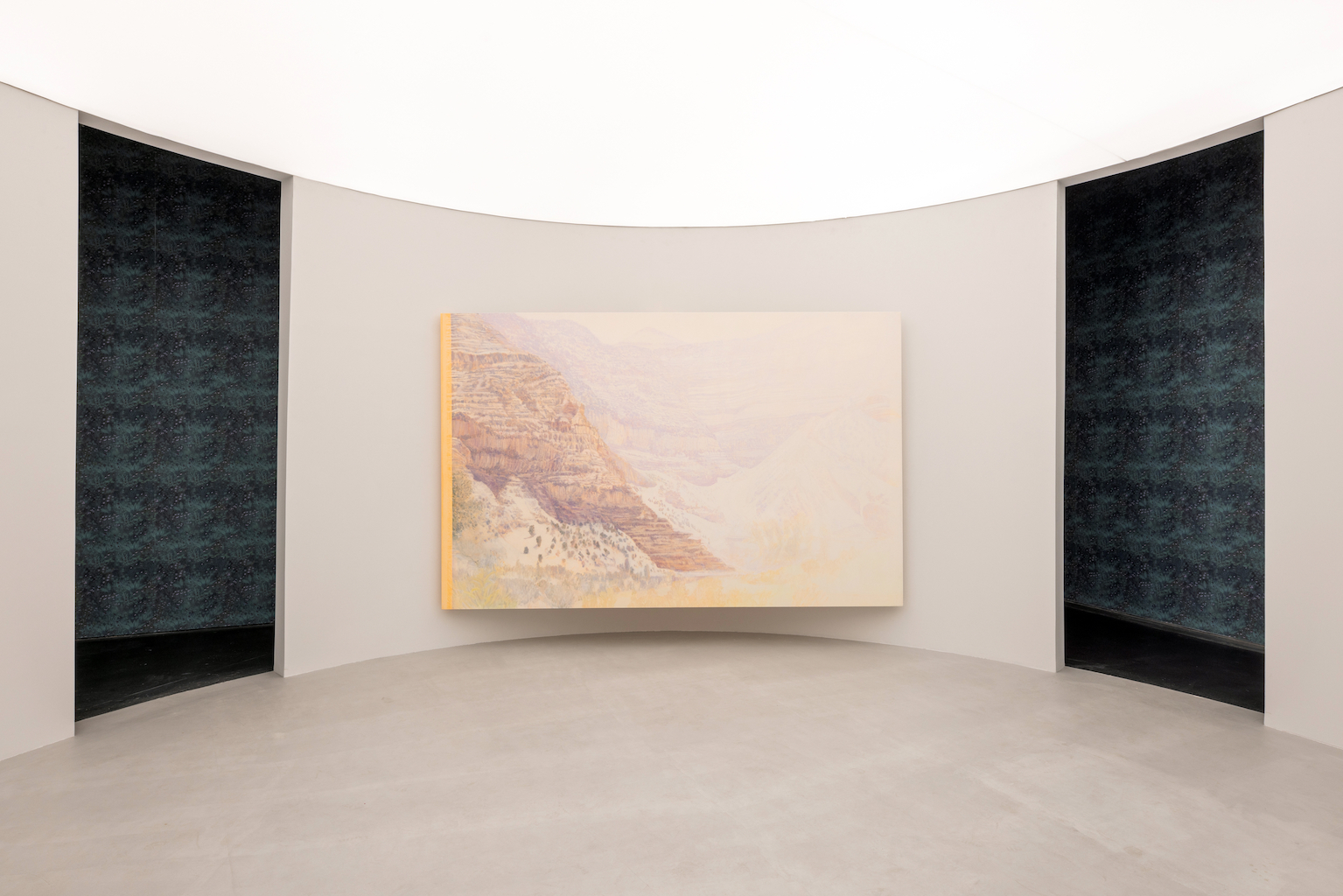 Daniele Genadry. The Fall, 2015. (Credit: Daniella Baptista, courtesy of the artist and Jameel Arts Center)
Daniele Genadry. The Fall, 2015. (Credit: Daniella Baptista, courtesy of the artist and Jameel Arts Center)
The more monochromatic “Blind Light” (2017) renders twin peaks in pinks and greens, the center of the canvas glowing to reflect the course of a light-scattering waterfall. Rendered in the most pale of orange, blue, purple and white, the triptych “Shimmer” (Cap Canaille) (2022) captures the Cape extending seaward, attended by a few islands. As Genadry notes, it requires a persistent and attentive gaze to discern the full color spectrum she’s using here.
“I’ve been thinking about these modes of vision and how to create a painted image that can act with a certain force on a viewer,” she reflects. “I have been working on it, in a way for the past 10 years, [regardless] where I’m working. I painted ‘The Fall’ in New York, working from images from Lebanon I took when I was in school. ‘Blind Light’ I worked on in Beirut, but it’s based on a photo by [Eadweard Muybridge (1830-1904)] of a place I’ve never actually been — Yosemite Park.”
She says “Shimmer” was painted “in direct relation” to Cap Canaille, off France’s Mediterranean coast, where she had a residency at the time.
“What connects these paintings, I think, is an interest in light and other natural forces, that I recognize most easily through landscape. It’s a force that is able to arrest or to pause or to create a kind of suspension that allows you to become aware, or conscious, and present to what you’re looking at.”
She pauses. “That’s the way I define beauty, actually. The force of beauty is not a set of aesthetic characteristics. Rather it relates to … that power, that force, to make you present with it — whether it’s a mountain that forces you into the present tense with its own presence, or the shimmering sea that mesmerizes you and captures you. [It’s] a kind of encounter that creates presence or suspends time.”
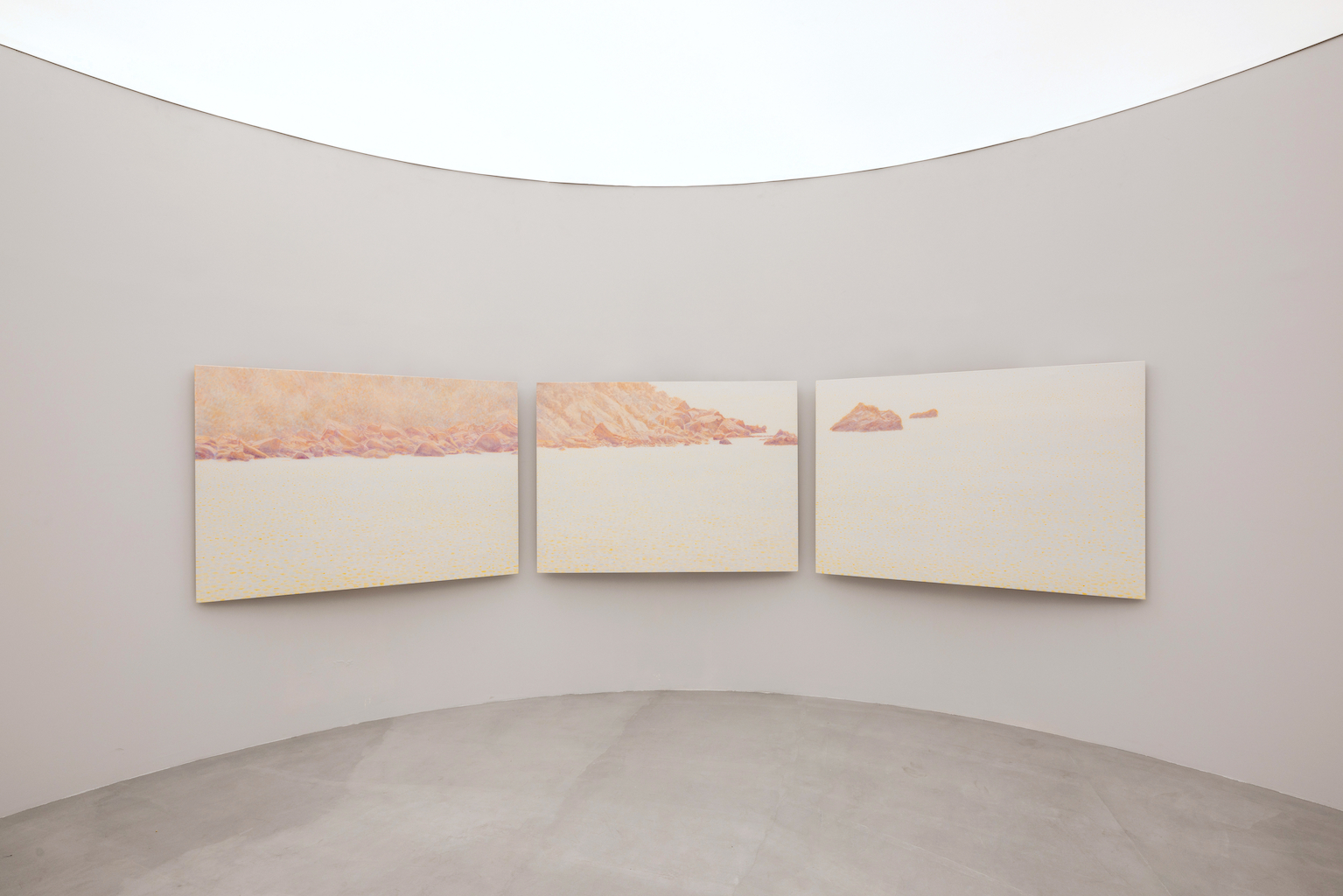 Daniele Genadry. Shimmer (Cap Canaille) triptych, 2022. (Credit: Daniella Baptista, courtesy of the artist and Jameel Arts Center)
Daniele Genadry. Shimmer (Cap Canaille) triptych, 2022. (Credit: Daniella Baptista, courtesy of the artist and Jameel Arts Center)
Genadry’s thoughts on beauty echo past generations of critics seeking to capture the sensation of losing yourself in the presence of art. Walter Benjamin, for instance, writes about the aura of a unique artwork, which he saw to be imperiled by the mechanical reproduction of images — photography and cinema.
In his essay “Apparitions,” written to accompany Genadry’s show, Chalabi suggests that contemporary life, bombarded as it is by images, makes encounters with beauty all too rare.
“Our epoch has produced a counterfeit of our world, a world made of clichés, quick-ready-to-consume images,” he writes. “In such a counterfeit world everything is already seen before it is encountered.”
Chalabi places Genadry’s work in an art historical context. In her aesthetics of presence he finds an expression of agency. Genadry speaks of the arresting suspension to be found in landscape in similar terms.
“For me it’s an important way of resisting,” she says, “another way of being in the world, of perceiving the world — it counters a gaze which is quick, distracted, hasty, unthoughtful.”
“I think it’s a generative thing, that heightened perception,” she adds. “I’m not making an argument that instability is good. I’m saying that there is also something important that emerges” from it.
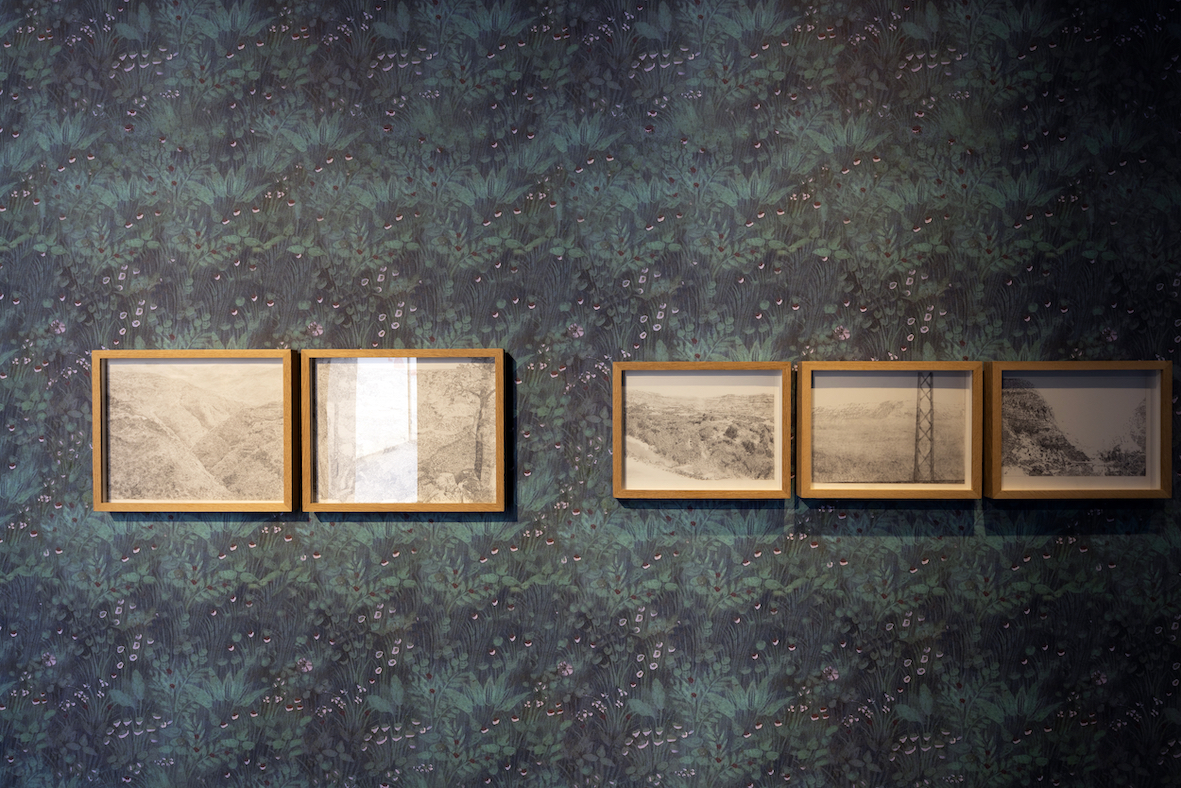 Daniele Genadry. Drawings 2014-2022. (Credit: Daniella Baptista, courtesy of the artist and Jameel Arts Center)
Daniele Genadry. Drawings 2014-2022. (Credit: Daniella Baptista, courtesy of the artist and Jameel Arts Center)
The resonance of Fra Angelico
On occasion Genadry’s work has referenced that of earlier artists. “Slow Light,” her 2018 solo at Beirut Art Center, found its inspiration in Muybridge’s work — specifically early photography’s failure to capture the image of rushing water, instead inadvertently catching the glow of light reflecting from its surface.
“Apparitions” has a less obvious art-historical touchstone in the Renaissance artist Fra Angelico (ca 1395-1455), in particular his fresco “Annunciation,” a depiction of an angel visiting the Virgin Mary, which he painted on the wall of a cell of San Marco Convent, Florence.
This work, Genadry says, provides “an instance where beauty functions as a force of stilling time, by creating a sense of an eternal present tense … It combined physical elements — such as the architecture of the space in which it was painted, which was repeated and included in the image; blotches of paint which stood out against the pictorial illusion, and shiny flakes that reflect actual light — into the fresco, and by doing so, juxtaposed the painted space with the actual one. This confusion of present context and painted image charges the space with a sense of presence.”
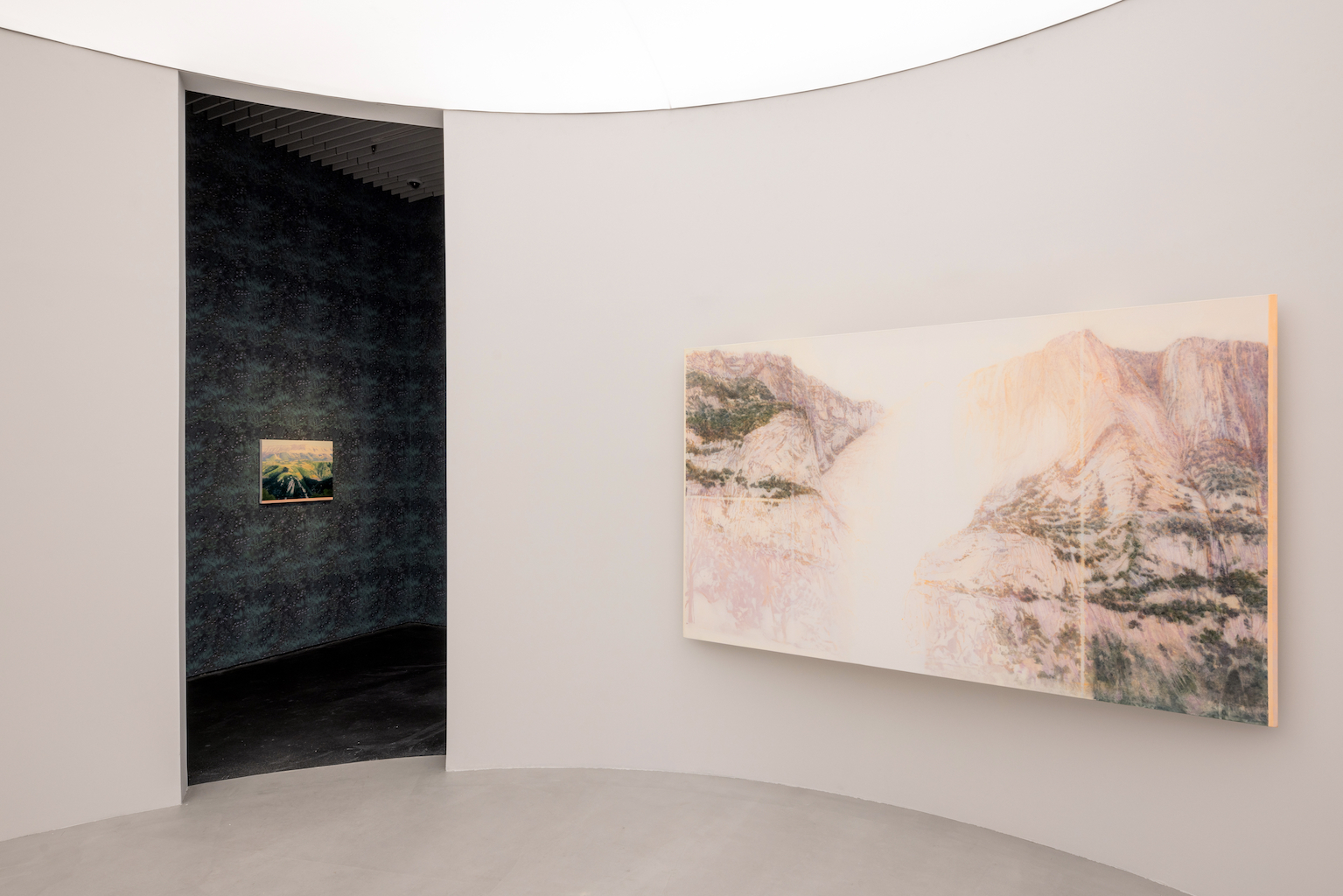 Daniele Genadry. Blind Light, 2017, right; The Illusion of light (mountain), 2022. (Credit: Daniella Baptista, courtesy of the artist and Jameel Arts Center)
Daniele Genadry. Blind Light, 2017, right; The Illusion of light (mountain), 2022. (Credit: Daniella Baptista, courtesy of the artist and Jameel Arts Center)
Genadry and Chalabi’s goal with “Apparitions” was to create a setting where visitors are more likely to find an apparition — not an angel or ghost in this case, but the mirage-like play of light on surfaces that the artist explores in her canvases.
To facilitate this, the collaborators erected a circular installation in the center of the gallery, creating two distinct spaces, differently lit and hung with works of distinct type and scale. The intimate exterior space, papered in a garden motif borrowed from Fra Angelico’s fresco, puts visitors in close proximity to a series of smaller works — most of them location studies pencil sketched by the artist in preparation for individual paintings.
The circular interior space, by contrast, is relatively expansive, Genadry notes, showing “open views (large paintings of the sea, mountain etc.) requiring a more distant gaze. This contrast between the two spaces aimed at heightening the viewers’ visual sensibility, in order to experience something akin to an ‘apparition’ when entering the circular space.”
The space’s lighting design emulates sunlight, she explains, challenging the viewer to distinguish the room’s physical light from that which seems to glow from the paintings themselves.
The installation is an intriguing inversion of the architectural experience of interior and exterior — as though the viewer had entered a traditional villa, emerging into a courtyard whose landscape is, ironically, unenclosed.
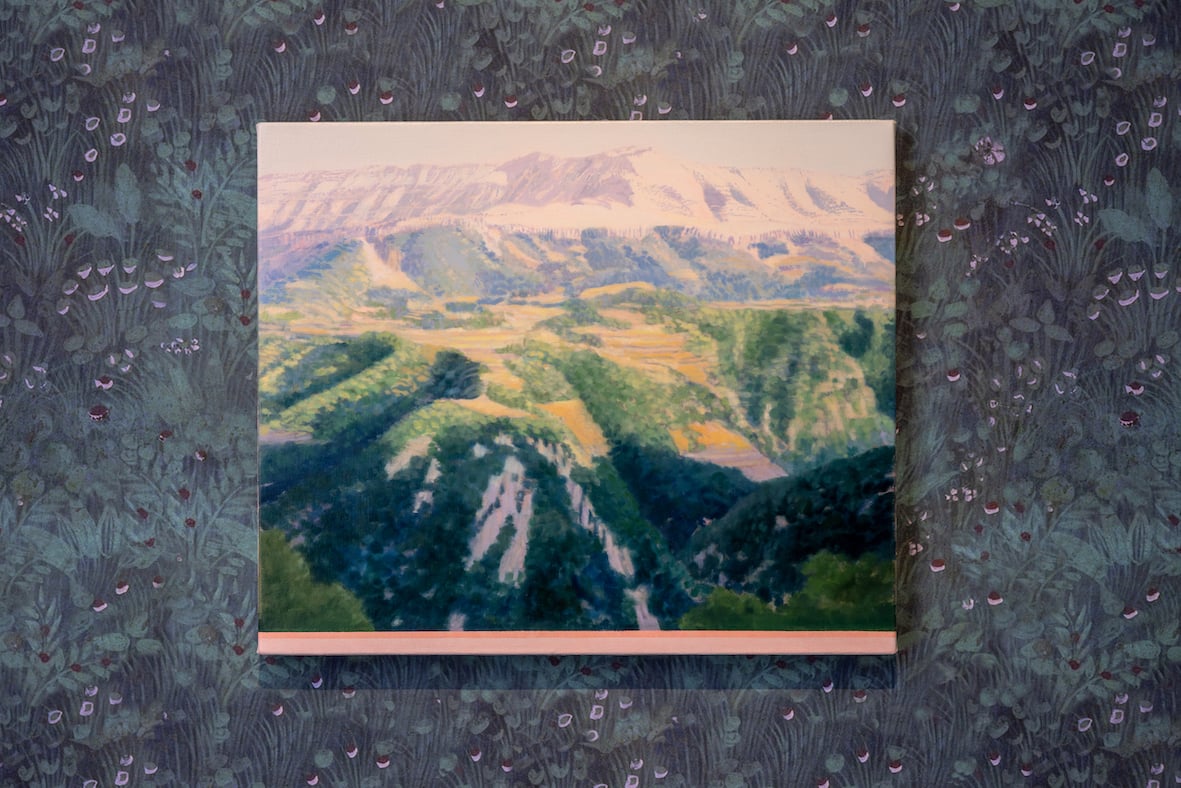 Daniele Genadry. The Illusion of light (mountain), 2022. (Credit: Daniella Baptista, courtesy of the artist and Jameel Arts Center)
Daniele Genadry. The Illusion of light (mountain), 2022. (Credit: Daniella Baptista, courtesy of the artist and Jameel Arts Center)
‘Apparitions’
Genadry’s exhibition is one of three solo shows currently up in the Jameel Art Centre (JAC)’s Artist’s Rooms. This show, she explains, centers on “Blind light,” now a part of JAC’s collection, around which she was invited to develop a project. She’s used it to explore three different qualities of light.
“‘Blind light’ relates to an over-saturating or maybe blinding glow light where it seems to emit from the middle of the painting,” she says, “like the flash of a camera or an overexposed photograph.
“I included ‘The Fall’ because that painting has to do with light that functions to create a sort of fragile, tenuous image — also over-saturating it, but with a very different quality than ‘Blind Light.’ The blinding glow in the ‘Blind Light,’ for me, is a shock of light. In ‘The Fall’ the quality of light is one that softly erases, like a haze that falls over everything.
“With ‘Shimmer’ I was thinking of a third quality of light which is this," she smiles, "a kind of vibrating, jumping, moving quality of light that is very tenuous in a different way, and mesmerizing.”
Daniele Genadry’s “Apparitions” is up at Jameel Art Centre’s Artist’s Rooms through 14 May. The three Artist’s Rooms shows are curated by Nadine El Khoury.